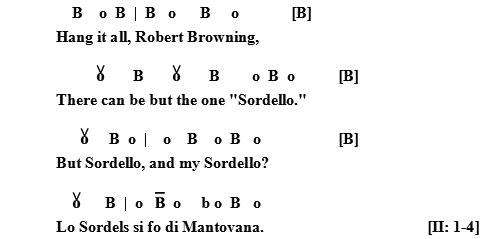| Phoneticians have long since described spoken English, and with great precision, but it wasn’t until Derek Attridge's The Rhythms of English Poetry (1982) that the revolution in linguistic science applied itself to our poetry. | 4 | He holds that poetic forms both exaggerate and regularize the natural intonation of speech; they are governed by inherent norms and expectations. Isochronosty of stress units (occupying equal amounts of time) takes precedence over that of syllable-length and count. A stressed syllable with its related unstressed counterparts (however many there happen to be) tend to be equalized. Of course, the time units never really achieve equality, but they do contribute to the regularity and alternation of rhythm characteristic of English poetry. The obvious examples come from nursery rhymes where rhythm is most notably exaggerated. “Thìs is the hoùse that Jàck buìlt.” The leading unstressed syllable is omitted – a strong attack as in the opening bar of Beethoven’s Ninth Symphony, but even so, the initial stress is less than those which follow. Language naturally compresses and elongates the timing of stress units whatever their syllabic length. Differentiations of pitch, which naturally accompany stress and juncture, add a vertical dimension to the forward thrust of cadence. Attridge writes: |
4 | London; Longman, 1982. |
|
|
||
Furthermore stresses in poetry are counted “by instinctively exaggerating their rhythmic function, turning them into beats at relatively equal intervals, and often accompanying each stress with a muscular movement. Listeners do not assess the acoustic properties of the sounds they hear, but take account of the pressures needed to produce [them]” (65-66). The constraint of syllable count in accentual-syllabic verse has far less influence than stress. On the other hand Beat/Offbeat scansion, as developed by Attrtidge, is, perhaps, overly stress-oriented and more or less neglects the importance of pitch, duration, and sound patterning. English intonation is, of course, not monotone and natural patterns include four distinct levels which indicate nuances of meaning, either grammatical or emotional. The mid tone (#2) constitutes a norm, and the lower (#1) indicates closure in indicative statements. The higher level (#3) falls on stressed syllables as well as marking internal juncture and closure in interrogative sentences. The fourth and highest pitch is purely emotive and registers surprise, anger, incredulity, etc. Moreover, regional and class dialects differ in patterns of intonation as well as pronunciation and also vary over time. Vowel length, for example, greatly affects the dynamic of poetic rhythm, and Pound spoke the so-called, cultured dialect of the Northeastern sea-board at the turn of the Twentieth Century – as did Teddy Roosevelt, etc. It was highly influenced by an antecedent Scots vernacular, with burred ‘r’s and some short vowels which in standard English are now long. Poetry for him, as for Yeats, was incantatory and he chanted (Sprechgesang) with pitch changes on whole tones as do professional actors. | 5 | Most native speakers use half or quarter tones and some regional dialects ignore them altogether – Mid-Western American and Southern Californian, for instance. In hard-nosed, tough-guy films of the 1930s and ‘40s, as well as in contemporary costume drama, pitch is often avoided in order to achieve a distancing effect – either a complete absence of emotion or rhetorical elevation. Normally, pitch change coincides with stressed syllables, and Attridge accounts for ‘duration’ in terms of stress, but that is not the only possible view. On 16 December 2007 David Moody wrote, privately:
Beat/Offbeat scansion (as developed by Attridge) offers a meaningful tool for dealing with The Cantos, and the following tabulation under six headings allows easy access to its major concepts: |
5 | Listen@Richard Sieburth, |
|
|
||
|
||
|
|
|
|
||
 |
||
|
||
 |
||
|
||
|
||
 |
||
|
||
| 1 | 2 | > | 3 | 4 | 5 | ||